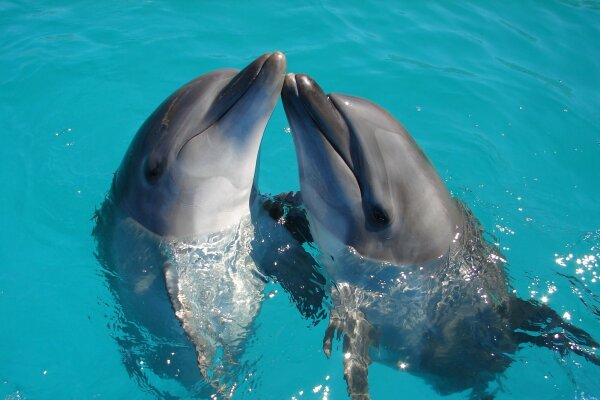2012-11-07

In a previous study biopsychologists from Bochum and Nürnberg had demonstrated that bottlenose dolphins can discriminate visual stimuli according to their numerosity (the number of objects displayed in pictures). But are dolphins able to use an abstract numerical category based on "few" vs. "many" when discriminating stimuli according to the number of their constituent patterns? And how do they mentally represent numerosity? To this end, a team of Biopsychologists from Bochum, Mallorca and Nürnberg trained Blue, an adult bottlenose dolphin, to discriminate between two simultaneously presented stimuli which varied in the number of elements they contained. After initial training, several confounding parameters were excluded to show that discrimination performance indeed depended on numerosity. Subsequently, the animal was tested with new stimuli of intermediate as well as higher numbers of elements. Once discrimination had been achieved, a reversal-training on a subset of stimuli was initiated. Afterward, the subject generalized the reversal successful to new and unreinforced stimuli. These results reveal two main findings: firstly, after reversal learning, Blue generalized the reversal successful to new and unreinforced stimuli. Thus, the results suggest that dolphins are able to learn and use a numerical category that is based on abstract qualities of "few" vs. "many." In addition, the occasional errors of Blue strongly suggest a magnitude and a distance effect. Thus, coding of numerical information in dolphins might follow logarithmic scaling as postulated by the Weber-Fechner law.

In a previous study biopsychologists from Bochum and Nürnberg had demonstrated that bottlenose dolphins can discriminate visual stimuli according to their numerosity (the number of objects displayed in pictures). But are dolphins able to use an abstract numerical category based on "few" vs. "many" when discriminating stimuli according to the number of their constituent patterns? And how do they mentally represent numerosity? To this end, a team of Biopsychologists from Bochum, Mallorca and Nürnberg trained Blue, an adult bottlenose dolphin, to discriminate between two simultaneously presented stimuli which varied in the number of elements they contained. After initial training, several confounding parameters were excluded to show that discrimination performance indeed depended on numerosity. Subsequently, the animal was tested with new stimuli of intermediate as well as higher numbers of elements. Once discrimination had been achieved, a reversal-training on a subset of stimuli was initiated. Afterward, the subject generalized the reversal successful to new and unreinforced stimuli. These results reveal two main findings: firstly, after reversal learning, Blue generalized the reversal successful to new and unreinforced stimuli. Thus, the results suggest that dolphins are able to learn and use a numerical category that is based on abstract qualities of "few" vs. "many." In addition, the occasional errors of Blue strongly suggest a magnitude and a distance effect. Thus, coding of numerical information in dolphins might follow logarithmic scaling as postulated by the Weber-Fechner law.